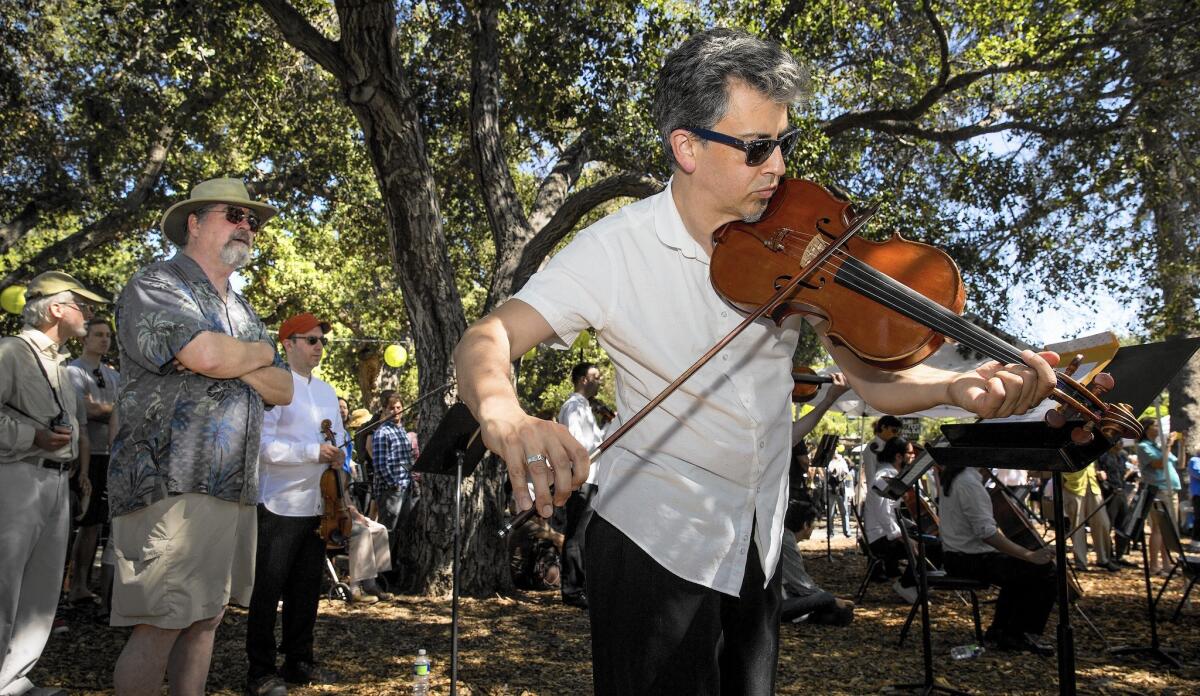Review: Feeling the sonic rush at the Ojai Music Festival

Reporting from OJAI — The first major work in Western music for percussion ensemble, Edgar Varèse’s 1931 “Ionization” instigated the percussion revolution in modern music. But Thursday night at the Ojai Music Festival, this year’s music director, percussionist and conductor Steven Schick, noted something possibly even more revolutionary about this 20th century classic.
Instruments from cultures unable to get along then or now were asked to sit side by side. Finding compatibility between European military snare drums, Latin American bongos, Asian gongs and African drums, Schick observed, could become “a model for an environment of cohabitation … that we could all aspire to live up to.”
Schick did not go so far as to propose compatibility and cohabitation as a festival theme. But by packing the 69th Ojai festival into marathon days of concerts from dawn (and before!) until midnight, he, in fact, turned the five-day festival into a de-facto Davos of musical diplomacy. No model society emerged, but there were helpful hints of how we might proceed.
In theory, the festival was meant to be Pierre Boulez-centric and thus a celebration of cerebral music. In honor of Boulez’s 90th birthday and in recognition of the French composer and conductor having seven times been Ojai’s music director, the festival began Wednesday in Libbey Bowl with a special multimedia Boulez tribute and ended Sunday with a performance of Boulez’s 48-minute “Dérive 2” from 2009 and one of his most recent works. There were further daily doses of Boulez, added to a heady diet of contemporary music.
Over five days at Ojai, Schick conducted dozens of works, ranging from Aaron Copland’s “Appalachian Spring” to the world premiere of Julia Wolfe’s string orchestra arrangement of “Four Marys.” ICE (International Contemporary Ensemble) was the impressive main instrumental group in residence, and Schick, who is based at UC San Diego, also led the San Diego ensembles red fish blue fish and Renga.
Indefatigable, Schick worked around the clock. On Friday night, he offered a flabbergasting recital of European, American, Finnish and Chinese avant-garde solo percussion pieces, including Vinko Globokar’s agonizingly outlandish “?Corporel,” in which a bare-chested Schick sat cross-legged and played his body. He followed that with a late-night appearance in Roland Auzet’s “La Cathédral de Misère” — a vulgar staging, with electronics and psychedelic lighting, of Kurt Schwitters’ “Ursonate,” a 35-minute Dada poem that Schick delivered with beyond-flabbergasting vocal virtuosity.
Saturday night found Schick conducting demanding 8 and 10:30 p.m. concerts in Libbey Bowl. On Sunday morning at 5 at the nearby Ojai Arts Center, he joined ICE flutist Claire Chase and pianist Sarah Rothenberg for Morton Feldman’s “For Philip Guston.” A score of repetitive, ethereal unworldliness, it lasted 4 hours and 38 minutes.
Some listeners brought sleeping bags to the arts center and were strewn on the floor as though stranded at an airport. The haunting bells, the call-to-prayer flute lines and solemn piano chords were given the added buzz of snoring.
Neither Schick, nor Ojai, can do it all. Late Feldman (“For Philip Guston” was written in 1984, three years before Feldman died) and late Boulez have little in common. The composers were born less than a year apart, and each accused the other of lacking elegance. This year, each might have been proved correct but not for their reasons. Feldman’s music goes back to essentials and cleans the air, leaving logic out of the equation. Boulez’s music is a fascinatingly complex world of expressive logic.
“For Philip Guston” was given a magisterial performance in a messy setting. “Dérive 2” had the opposite problem of seeming too well scrubbed. While ICE played brilliantly, Schick’s conducting, which lacks the nuance of his solo playing, allowed no room for essential messiness, the expressivity of the intricate little details that give Boulez’s music its life.
Nor was mixing small earlier Boulez pieces with Bartók string quartets in early evening concerts illuminating. Although a great Bartók conductor, Boulez always considered the Hungarian the least important to him of the great 20th century composers. But the refined yet visceral Bartók performances by the Calder Quartet were commanding.
Still, Schick was terrific at providing an atmosphere in which musical reactions might occur. The West Coast premiere Thursday afternoon of John Luther Adams’ recent “Sila” for dozens of musicians stationed around Libbey Park gave the impression of the trees taking audible breaths, the ground groaning, the wind in happy duet with the flowers and the stones dancing. I have never seen such contented-looking musicians and listeners.
At the other extreme, Schick conducted a strong performance of Varèse’s lonely, pessimistic “Déserts” later that night, and the environment now felt in danger. But a couple of nights later, Adams came to the rescue with his fluid, life-affirming “Become River” for chamber ensemble.
The Israeli cellist Maya Beiser proved particularly effective in tapping into Ojai’s spiritual essence with Michael Harrison’s droning, electronic “Just Ancient Loops” (accompanied by a Bill Morrison film) and her chanting in Mohammed Fairouz’s haunting arrangement of the Kol Nidrei.
Wu Man was the soloist in Lou Harrison’s Concerto for Pipa With String Orchestra, but here there could be no cultural detente with an eloquent Chinese soloist and Renga’s poorly tuned and timid strings.
Olivier Messiaen’s two-piano “Visions de l’Amen” added mystical Catholicism to the mix, and a glorious Ojai moment was the Saturday morning performance by Gloria Cheng and Vicki Ray. Messiaen had been Boulez’s teacher, but the connection was curiously stronger with Feldman, whose “For Philip Guston” has a mystical Jewish character.
There were vast amounts more, too much to absorb, reminding us that marathon diplomacy is show business and that real understanding takes time. Nonetheless, Schick demonstrated that there is no place better for real peace talks than Ojai, something musicians this year knew well and something that governments would do well to check out next year, when Peter Sellars will be the music director.
More to Read
The biggest entertainment stories
Get our big stories about Hollywood, film, television, music, arts, culture and more right in your inbox as soon as they publish.
You may occasionally receive promotional content from the Los Angeles Times.











